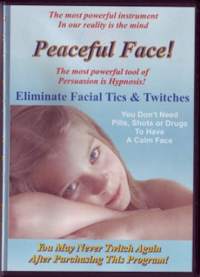Facial Tics and How to Obliterate Them
By Alan B. Densky, CH
Young children frequently develop muscle spasms of the face or extremities that are repetitive and troublesome. Some examples of these spasms include eye blinking, squinting, nose wrinkling, facial grimacing, throat clearing, or grunting. These facial grimaces are often referred to as tics, and can be very uncomfortable and embarrassing for those children who experience them. Sometimes, but not always, these tics disappear as the child grows into adolescence or adulthood.
Although facial tics usually become obvious during early childhood, some people may not develop them until early adulthood. These individuals may begin to have problems with mouth twitches, rapid eye blinking or even repetitive throat clearing during episodes of stress or intense professional or personal pressure. In some cases, however, tics such as squinting, clearing, or grunting may also result from head trauma or adverse drug reactions.
Some of these problems, such as nose wrinkling or throat clearing, may be mildly annoying. Tics such as those experienced by persons affected by Tourette Syndrome, however, such as grunting or facial grimacing, can be much more severe and problematic. Individuals who experience these problems may experience social ostracization, particularly during childhood, when the frankly cruel honesty of children can be extremely painful.
Tourette
Syndrome is a complex problem that is sometimes viewed as an extreme example of
facial tics. This complex neuromuscular problem is not easily treated. Some
medications, such as anxiety-reducing drugs, often help decrease the severity or
frequency of the spasms. In some cases, doctors even prescribe anti-psychotic
medicines to help reduce their occurrence. Drugs alone, however, are not
sufficient to help the person to heal completely from the disorder; they almost
never eliminate the tics entirely.
Perhaps the most dismal aspect of Tourette Syndrome, particularly to sufferers
and their families, is that the disorder begins with mild symptoms such as
facial grimacing, eye blinking, or squinting, and then progresses to more
complex manifestations such as throat clearing, grunting, or other repetitive
noises. People with this disorder often find personal and professional
relationships very difficult to manage because of the social embarrassment
produced by these uncontrollable spasms.
Other options for treatment of this disorder, as well as milder facial tics,
include behavioral therapy and relaxation exercises such as guided imagery.
Because these problems occur most often when people are under stress,
professionals attempt to assist the client to reduce their anxiety levels and
manage stress more effectively. Unfortunately, however, many people become less
anxious and more relaxed - until the next stressful situation, when the tics
often manifest as severely as or even more severely than before.
Some professionals use less conventional therapy approaches for eliminating
facial tics such as mouth twitches and nose wrinkling. Treatments such as
hypnosis can be very effective in eliminating or at least reducing the
occurrence of these muscle spasms. Some self-hypnosis programs are available,
and are usually offered on CDs so that clients can practice the recommended
techniques in the privacy and comfort of their own homes. Traditional hypnosis
and self-hypnosis however, are more useful with suggestible people than with
analytical people who tend to think critically to solve problems.
Other alternative therapies that have demonstrated much more effectiveness than
traditional hypnosis or self-hypnosis in this group of people are Ericksonian
Hypnotherapy and Neuro-Linguistic Programming.
Ericksonian Hypnotherapy utilizes conversational hypnosis and metaphors to
communicate suggestions in such a way that a person's conscious mind doesn't
realize suggestions are being made, so it is much less likely to put up barriers
to the new ideas.
NLP is a technique that allows trained NLP Practitioners to help clients
reprogram their minds to overcome many difficulties. This approach can be used
to help people with a wide variety of facial tics, including mouth twitches, to
actually obliterate the problem altogether by assisting them to eliminate stress
from their lives.
With one powerful NLP technique, clients are taught how to flash away stress by
programming their unconscious to use stress-producing thoughts as triggers for
happy memories that cause feelings of peace and tranquility.
Another NLP technique helps the client to anchor these happy memories
kinesthetically by touching two fingers together while deep in a memory. During
stressful situations, clients are then encouraged to trigger the anchor to
re-experience the feelings of peace and tranquility. So rather than experiencing
stress, they experience calm and relaxation instead.
Similar anchoring techniques can be used to momentarily disassociate during
periods of extreme anxiety, which can eliminate the compulsion to twitch or tic.
This therapy is a useful method of helping people to eliminate mouth twitches
and other facial tics. Unlike conventional therapies that focus on stress and
finding ways to reduce it, many of the NLP techniques focus on eliminating
stress altogether. People then experience relief from the compulsive facial tics
that have for many years caused them to experience problems with self-esteem and
self-image in personal and professional relationships.
Summary: Facial tics such as grunting; eye blinking, and throat clearing
can be painful and embarrassing for the children and adults who experience these
uncontrollable spasms. Medications and behavioral therapy help to decrease, but
do not usually eliminate, the occurrence of tics. NLP is a newer, alternative
therapy designed to help sufferers gain freedom by eliminating the experience of
stress during times or situations that would normally produce anxiety and a
compulsion to twitch.
©2007 By Alan B. Densky, CH.
This document may NOT be re-printed. All
Rights Reserved.



